We have many blessings in this country, not least of which is our Constitutionally guaranteed right to keep and bear arms. At times, the toolbox from which we draw to exercise and defend this right overflows with options. Exhibit A: the ever-growing crop of modular rifles. This bounty can be overwhelming when so many manufacturers claim to offer a one-size-fits-all rifle solution. Primary Weapons Systems has introduced its new UXR in hopes of standing out above the competition.
The UXR shares several characteristics with other 21st-century semi-automatic-rifle designs. Its streamlined profile blends aluminum, steel and polymer. The rifle functions with its stock folded, is left- and right-hand friendly and is operated by a long-stroke-piston operating system. More significantly, the UXR’s Barrel Xchange System allows users to swap chamberings or lengths with minimal effort.
The UXR’s polymer shell deflector is effective and minimalist • Unlike an AR-15, the UXR’s upper receiver is the serialized part and therefore legally the firearm.
Like many of its predecessors, the UXR’s upper is the serialized receiver. Except for a polymer brass deflector and stainless-steel bolt-carrier guide rails, the receiver is made from a single piece of 7075-T651 aluminum. It houses a surprisingly compact, AR-180-esque bolt-carrier group with a double-ejector-equipped bolt. The gas system is protected by the receiver’s 17.5-inch-long top rail and removable handguard. Charging the rifle is done by way of a forward-mounted, non-reciprocating, reconfigurable, folding handle.
Juggling skills may prove helpful when switching the charging handle from one side to the other. While holding the rifle steady, a captive detent must be depressed with a small tool (or cartridge tip), while the tight-fitting charger is unlatched and driven off its track. Reinstallation is easier, and unlike some reconfigurable side-chargers, you can be pretty certain that the UXR’s charging handle won’t come off accidentally.
The rifle’s gas block is fronted by a three-position “rocker valve” that’s adjustable for suppressed, normal and adverse conditions. The lever is accessible through large side ports, just under the top rail and forward of the charging-handle groove. Initially, changing settings required a Delrin punch and light hammer taps to override the detent. After a couple drops of oil and a few adjustment cycles, I was able to push it into any position with a cartridge tip, as designed.
Just ahead of the gas block, a short, bulbous bore evacuator surrounds the barrel. Similar to those found on tanks and artillery pieces, its main purpose is to draw excess gasses away from the shooter and out through the muzzle, especially during high rates of fire or suppressor use. The muzzle is fronted by PWS’ FRC Compensator. In addition to serving as an effective brake, the comp has a taper seat and threads for Rearden’s Atlas-pattern suppressor mounts.

A full-length rail atop the UXR leaves plenty of room to mount optics, including clip-on night vision • The adjustable Triggertech trigger proved excellent in testing • Thanks to its piston-driven operation, the UXR’s stock can fold with no modifications • The buttstock itself is fully adjustable and sports a textured buttpad • PWS’ FRC Compensator also acts as a suppressor mount.
Back at the polymer fire-control housing, the ambidextrous theme continues with low-profile, short-throw, ambidextrous selector paddles. Large magazine-release buttons are positioned high on each side, at the rear of the mag well. Bilateral bolt-stop levers are nested forward of the trigger guard and flush with the bottom of the mag well. Pushing either side up, while holding the charging handle to the rear, will lock the bolt rearward.
The bolt-stop levers are well positioned for trigger or middle finger access, but I was unable to release the bolt with either finger due to the stiffness of the mechanism. Whether due to my gnarled hands or new parts needing to wear-in, I had to pull downward with my thumb to release the bolt. Of course, once a loaded magazine has been inserted, fully retracting and releasing the charging handle achieves the same thing.
The fire-control housing is compatible with most AR-pattern pistol grips and trigger assemblies, but the factory options worked well for me. The trigger unit, made for PWS by Triggertech, has an adjustment range of 2.5 to 5 pounds. Though a single-stage design, my test sample had a very short take-up that wasn’t quite a first stage, but was measurable at a consistent 7 ounces. After a simple adjustment from the factory settings, total pull weight was a comfortable, crisp-breaking 2.5 pounds.
The UXR’s aluminum, side-folding stock attaches to a short rail section at the rear of the trigger housing. Changing the direction of fold is easily accomplished by removing three screws and reversing the assembly’s hinge. The stock has minimal play when extended and folds effortlessly via a textured button that’s found on whichever side the stock is set to fold toward.

The rifle’s mag well is removable to ease maintenance, change certain calibers and swap barrels • Located in a spot familiar to AR users, the safety selector is ambidextrous.
Large, bilateral buttons near the rear of the stock allow adjustments for length-of-pull through six positions, covering a 2.5-inch range. A .25-inch buttpad provides shoulder comfort, while a push-button, two-position, polymer cheekpiece allows .25-inch of additional comb height for optic mounts. A total of four QD sockets are positioned astride the rear of stock and at the bottom/rear of the fire-control housing.
Change is Good
Removing the UXR’s freefloat barrel is a simple process that begins with ensuring the rifle is unloaded. Driving out the captive rear takedown pin allows the fire-control housing and stock assembly to be removed with a stiff, rearward pull. If desired, the polymer mag well can also be pulled rearward and down off its receiver track at this point. With the bolt still forward, the rear of the recoil-spring guide is then depressed slightly, lowered and removed—with the spring—through the receiver’s rear opening. Retracting the charging handle brings the bolt-carrier group back for removal. Forward of the mag well and high on the polymer trunnion cover, each of the barrel clamp’s three 5/32 (hex) trunnion screws are then loosened by two turns, allowing the barrel assembly to be pulled forward and free of the receiver. The barrel and piston assembly are now fully accessible for maintenance or replacement.
Reinstallation—with the same or different barrel and bolt assemblies—is accomplished by reversing this process. A torque wrench will be required to meet the manual’s specified 80 inch-pounds of torque for the trunnion screws. Independent of this process, the aluminum freefloat handguard can be removed by driving out the captive forward pin and sliding the tight-fitting tube forward, off its receiver tracks. The handguard features M-Lok slots on each side, the bottom and at 1 and 11 o’clock.
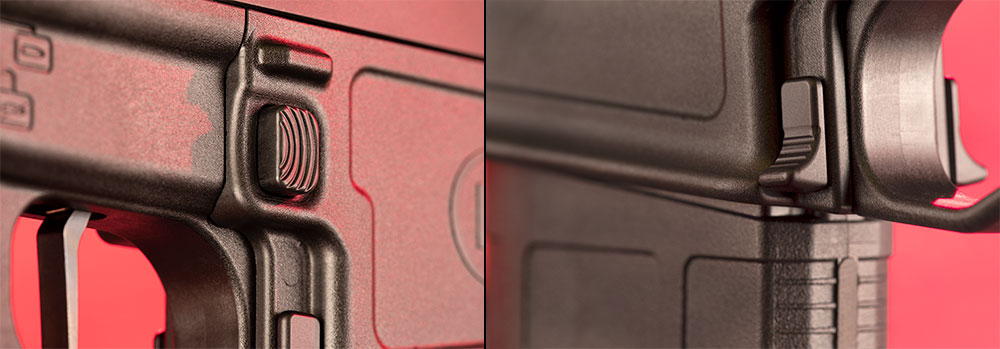
The magazine-release button is in a familiar spot and is ambidextrous • The bolt-catch levers are located at the rear of the trigger guard and operate vertically.
Proofing the System
Before I could verify PWS’ two accuracy-specific guarantees, I had to deal with some glitches. I assumed that the muzzle brake would be compatible with Q’s Cherry Bomb mount system, since Rearden claims that for its Atlas mounts. While my suppressors did fit the threads and seat tightly, a suppressor-alignment rod yielded a scant .002-inch clearance on one side of the suppressor’s end cap. Since that suppressor had an easily replaced endcap, and because I have access to a test facility with ballistic protective screening for the shooter, I decided to test the suppressor despite the poor alignment.
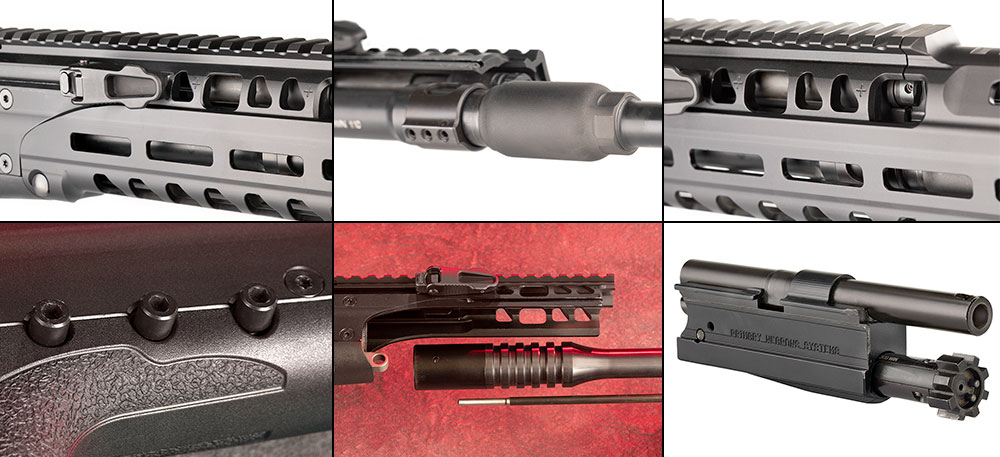
Folding and non-reciprocating, the UXR’s side-mounted charging can be mounted on either side • A bore evacuator ahead of the gas block helps divert gasses toward the muzzle • The three-position gas block can be adjusted with a cartridge tip • Three hex screws hold the barrel in place • Remov-ing those screws allows for easy barrel swaps • The BCG is designed to make swapping bolts easy when changing calibers.
My first range session was further confounded by continual failures of the bolt to fully close on a chambered round. The problem was present with all three match loads tested and required me to use the “adverse” gas setting, both suppressed and unsuppressed, in order to keep the rifle running. Even with the gas regulator fully opened, I still had occasional bolt-closure failures with the match loads.
The only ammunition that fed correctly was CBC’s 145-grain FMJ load, which I used for prone-supported zeroing and close-range drills while standing. This ammo tends to run “hot” in most semi-autos, which may be why it powered through the problem in both suppressed and unsuppressed modes. I relayed my experience to PWS and was informed that some production rifles have excess protrusion of the extractor-support pin inside its barrel extensions. Since that condition could definitely interfere with the extractor and affect bolt closing, it fit the problem.
Six days later, a replacement barrel and headspaced bolt arrived. After installing them, I again checked suppressor alignment, which was worse than the first time. The only suppressor that allowed the alignment rod through had just .001 inch of clearance with the end cap. That’s too close for comfort, but I decided to use it anyway in hopes of fully evaluating the suppressed gas setting.
Unfortunately, I only managed two suppressed shots this time. The first round impacted 6 inches wide of the preceding unsuppressed shots. After the second round went off target, I unloaded the rifle and inspected the suppressor’s endcap. Even in the shade, it was easy to see a telltale copper drag mark on the inside edge. Thankfully, no damage was done. This underscores the need to check new rifle-and-suppressor alignment prior to firing. If you don’t have visible, even clearance all the way around, seek professional help to correct the problem before sending rounds downrange. I did so in order to evaluate the rifle and only in a safe, controlled setting.
The second round of testing went perfectly on the functional front. The only oddity was that after firing the last round of every magazine, the charging handle unlatched itself and slid rearward. After verifying that I wasn’t imagining things, I blocked the latch’s movement to ensure the charger wasn’t accidentally reciprocating. It was not, so I figured that the handle was simply unlatching due to the shock caused by the bolt catch suddenly stopping the bolt in mid-cycle on an empty magazine. I mentioned this to PWS, and the company confirmed that the torsion spring—which locks the charging handle into its pocket—had recently been found lacking and that a remedy was in the works.

As is common with rifles that have piston assemblies above the barrel, the UXR’s receiver sits higher over bore than more common, direct-impingement rifles. Tall scope mounts may be too high for comfortable use, but that’s easily remedied with a reduced-height mount. Whether due to the lower bore or overall design, the UXR handled extremely well. I tested a 16-inch-barreled, direct-impingement SIG Sauer 716 a few days after the UXR, using the same ammunition. Despite weighing three-quarters of a pound more than the UXR, shooting the SIG was akin to laying belly-down on a rodeo bull in comparison.
Regarding PWS’ accuracy guarantees, the 1-MOA capability was easily verified. That it printed sub-MOA groups from two of the match loads tested and averaged 1 MOA at 100 meters with the best of them points toward good accuracy potential. Regrettably, due to the earlier functional problems and the time lost waiting for the replacement barrel assembly, I was unable to test its guarantee that the rifle will return to within .5 MOA of zero after a barrel is removed and the same barrel reinstalled.
Interestingly, the standard deviations for muzzle velocity were higher than I normally see in all three loads tested. Nonetheless, velocity averages were in their normal ranges. Since I expended a dozen rounds before finding the right sensitivity level for the chronograph and these were known ammo lots, I’m chalking the high SDs up to my equipment, rather than the rifle or ammunition.
All told, my 185-round UXR evaluation was positive. PWS appears to be addressing the bugs I encountered, which should give the rifle a good chance at commercial success. The UXR’s out-of-box accuracy, left- and right-hand-friendly controls and ease of barrel and mag well changes make this an attractive package for modular-rifle aficionados. With the current .308 Win., .223 Wylde and .300 BLK chamberings soon to be joined by 7.62×39 mm, 6.5 Creedmoor and 8.6 BLK, the UXR will take another step in the direction of a “one rifle to rule them all” solution.


Read the full article here

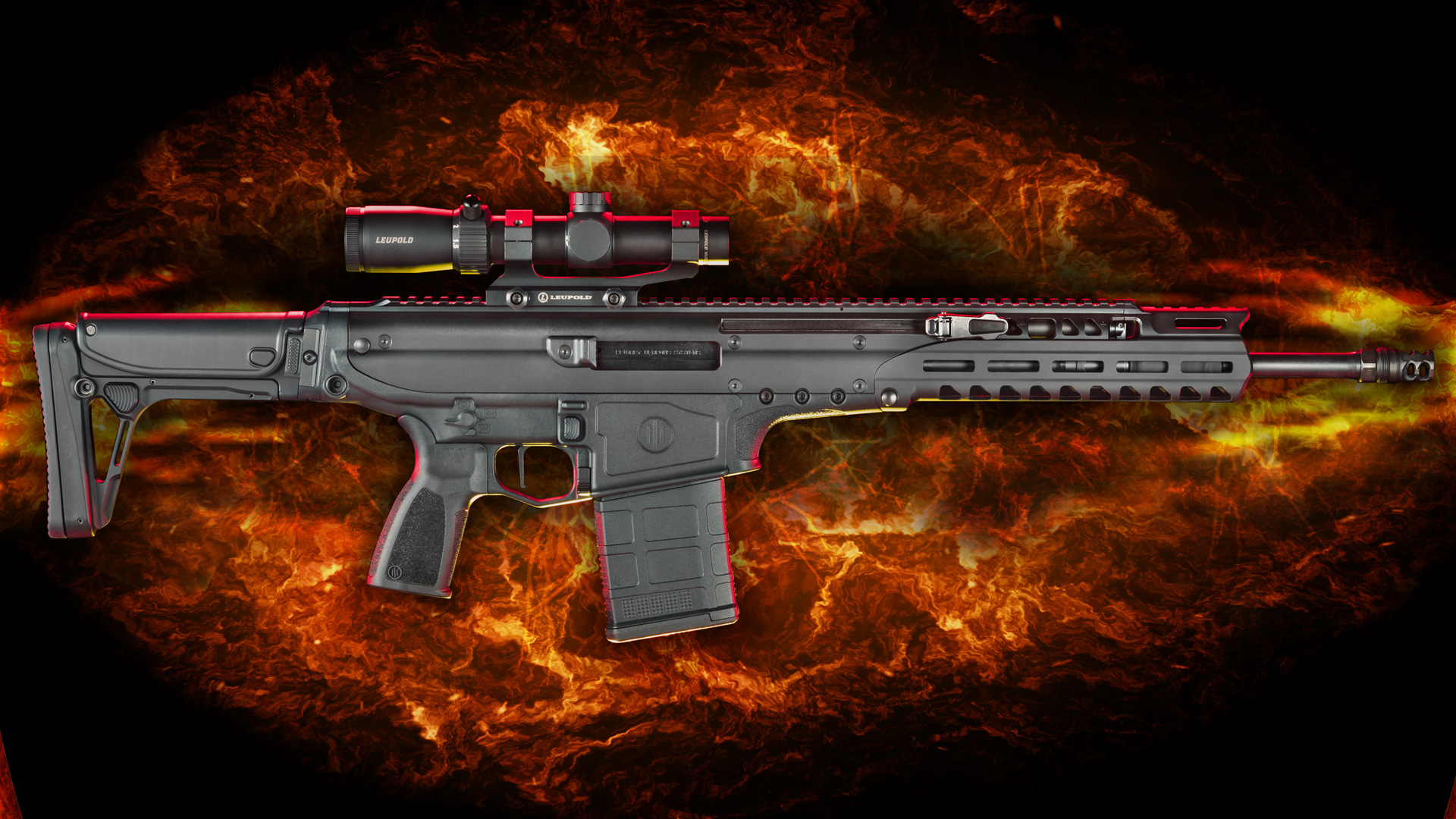



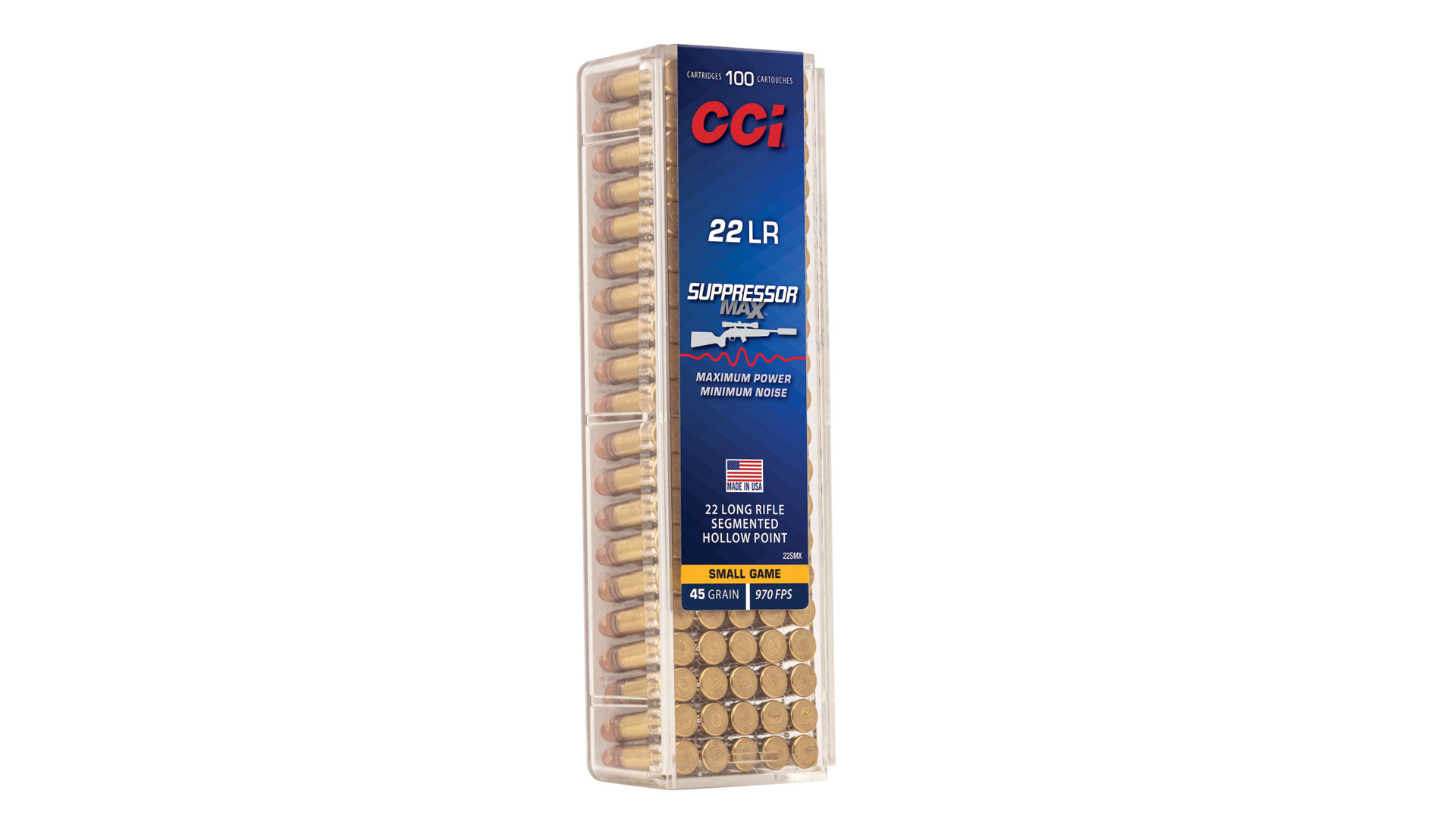
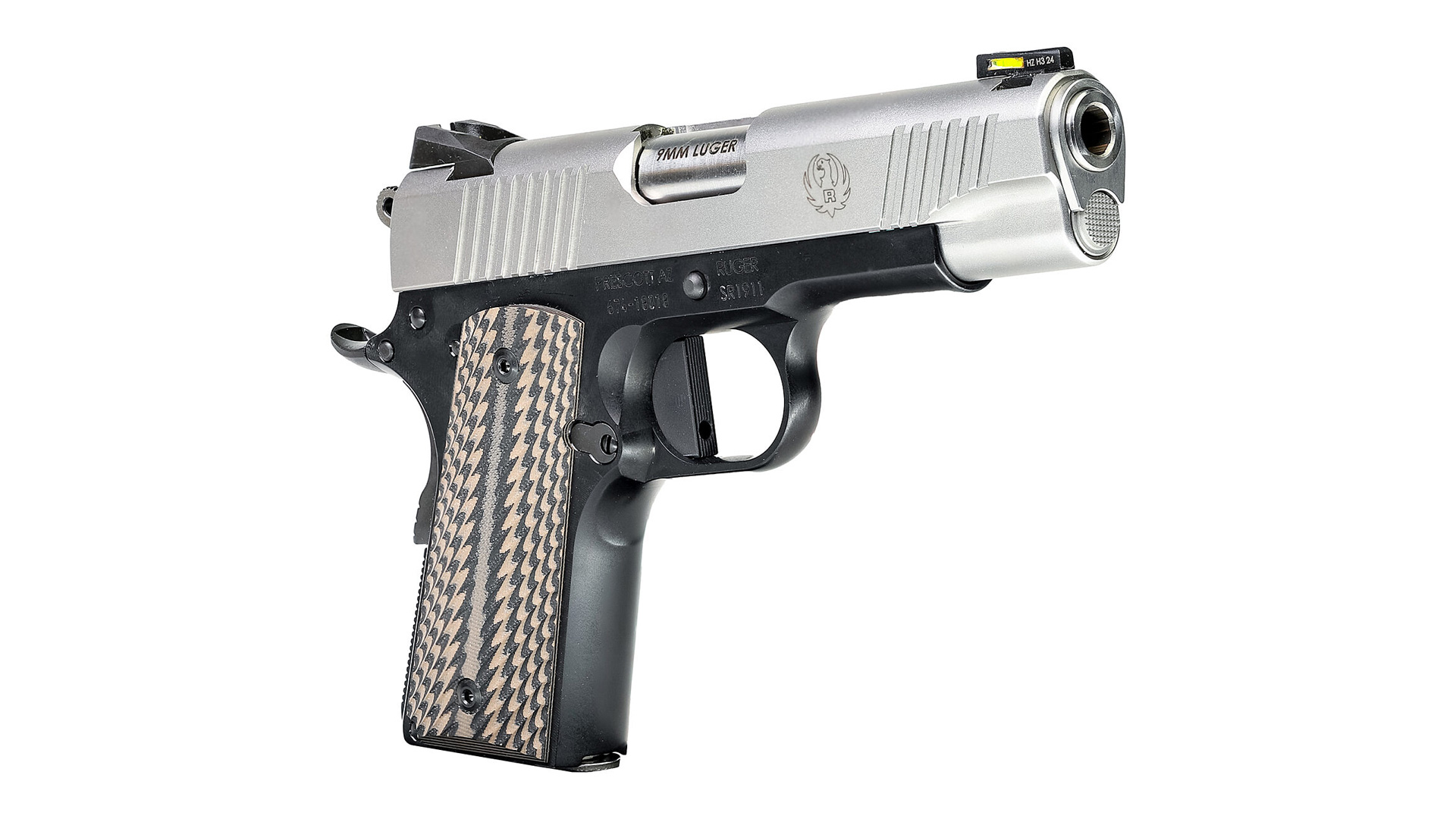
Leave a Reply